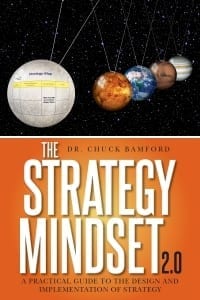Strategy Is a Process
 For as long as the word “strategy” has been in use it has been represented as something mythical. Many seminal articles have been written that describe what business strategy is, what it’s not, how to know if you have a strategy, how to test your strategy – and the list goes on. Even for those companies that understand the process, some do it very well and some do it very poorly.
For as long as the word “strategy” has been in use it has been represented as something mythical. Many seminal articles have been written that describe what business strategy is, what it’s not, how to know if you have a strategy, how to test your strategy – and the list goes on. Even for those companies that understand the process, some do it very well and some do it very poorly.
Why has the process of developing and implementing a business strategy been so hard for businesses to utilize? Foremost is that, because the concept has been so misunderstood, many companies believe they have a strategy or — even more dangerously — they’re implementing a strategy by relying on erroneous ideas about what constitutes strategy. These include such persistent myths as:
- Our people are our strategy
- Customer service is our strategy
- Our brand is our strategy
- International growth is our strategy
None of these is a strategy! Some represent unfocused hopes, while others are just platitudes.
For example, having employees implement a strategy to provide customer service is simply the orthodox (table stakes) element that organizations must deliver to remain viable. Providing standard customer service doesn’t separate an organization from its competitors in the eyes of the customers. Furthermore, absent very carefully designed guardrails, each employee will decide what constitutes ‘good’ customer service.
Strategy is a process that, at its core, consists of designing and implementing elements of the organization that will draw customers past your competitors, allow you to charge more than your competitors and/or provide you with a cost advantage.
Regardless of how you decide to approach strategy in your organization, do it with an understanding of what really works. This means taking a logical, research- and practice-based approach to defining, crafting and executing organizational strategy.
Strategy is still mostly art, but by remaining disciplined and analytical about the elements, your company will be far ahead of your competitors.
Apply these guidelines in your process-oriented approach to strategy:
1. Strategy starts external to the organization. A winning business strategy must focus on why customers really buy a product or service from an organization, and what distinguishes that purchase in the eye of the customer. This requires taking the perspective of the customer.
2. Bring conventional operations up to the median expectation. Assess what is orthodox, or the table stakes, for the organization in the eyes of the customer. Focus on those parts of the organization that are below the median expectations and are frustrating to customers. This may involve ensuring that employees are doing their jobs and doing them well. Exceeding the median expectation for standard elements of business is simply wasted money.
3. Identify the organization’s competitive advantages. While half of business strategy is maintaining conventional operations at or slightly above the median customer expectations, the other half is focusing the entire organization around true competitive advantages. To identify your competitive advantages, list all current and potential elements of the business that will encourage customers to go past your competitors and buy from you. Analyze each of them with some version of Resource-Based Analysis to determine those that constitute a true advantage. A business needs to have two or three true competitive advantages.
4. Optimize organizational structure. The next step is to develop operational plans that address every element that survives your resource-based analysis, along with every orthodox element that’s determined to be below median expectations. Implementation of strategy is difficult and often frustrating, particularly when employees don’t understand why a structure has been put in place or how it will work. Strategy can only be implemented by the employees of the organization, therefore it’s best to have employee participation in the process so that they embrace the approach.
5. Rework the mission around the strategy. Aligning the entire company around the strategy requires a unifying mission. An effective mission statement must be short, simple, specific to the organization and able to focus everyone’s energy. A great check on the quality of the mission statement is the leadership’s ability to design metrics that measure each part.
Strategy is not magic, it’s not wishful thinking and it’s not platitudes. Strategy is hard work that requires significant thought by organizational leaders. Utilizing a real process to craft strategy allows the organization to win over new customers and more easily retain current ones.
About the Author














Leave a Reply
Want to join the discussion?Feel free to contribute!